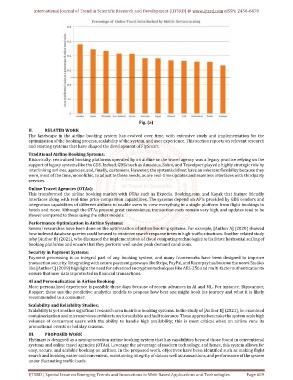Page 619 - Emerging Trends and Innovations in Web-Based Applications and Technologies
P. 619
International Journal of Trend in Scientific Research and Development (IJTSRD) @ www.ijtsrd.com eISSN: 2456-6470
Fig. (a)
II. RELATED WORK
The landscape in the airline booking system has evolved over time, with extensive study and implementation for the
optimization of the booking process, scalability of the system, and user experience. This section reports on relevant research
and existing systems that have shaped the development of FlySmart.
Traditional Airline Booking Systems:
Historically, centralised booking platforms operated by an airline or the travel agency was a legacy practice relying on the
support of legacy systems like the GDS. Indeed, GDSs such as Amadeus, Sabre, and Travelport played a highly strategic role by
interlinking airlines, agencies, and, finally, customers. However, the systems did not have an inherent flexibility because they
were, most of the time, monolithic, to adjust to these needs, as are real-time updates and seamless interfaces with thirdparty
services.
Online Travel Agencies (OTAs):
This transformed the airline booking market with OTAs such as Expedia, Booking.com, and Kayak that feature friendly
interfaces along with real-time price comparison capabilities. The systems depend on APIs provided by GDS vendors and
integration capabilities of different airlines to enable users to view everything in a single platform from flight bookings to
hotels and more. Although the OTAs present great convenience, transaction costs remain very high, and updates tend to be
slower compared to those using the other models.
Performance Optimization in Airline Systems:
Several researches have been done on the optimization of airline booking systems. For example, [Author A] (2020) showed
how indexed database queries could be used to minimize search response times in high-traffic situations. Another related study
is by [Author B] (2021), who discussed the implementation of cloud computing technologies to facilitate horizontal scaling of
booking platforms and ensure that they perform well under peak demand conditions.
Security in Payment Systems:
Payment processing is an integral part of any booking system, and many frameworks have been designed to improve
transaction security. Integrating with secure payment gateways like Stripe, PayPal, and Razorpay has become the norm. Studies
like [Author C] (2019) highlight the need for advanced encryption techniques like AES-256 and multi-factor authentication to
ensure that user data is protected in financial transactions.
AI and Personalization in Airline Booking:
More personalized experience is possible these days because of recent advances in AI and ML. For instance, Skyscanner,
Hopper: these use the predictive analytics models to propose how best one might book his journey and what it is likely
recommended to a consumer.
Scalability and Reliability Studies:
Scalability is yet another significant research area in airline booking systems. In the study of [Author E] (2021), he examined
containerization and microservices architectures for scalable and fault tolerance. These approaches make the system scale high
volumes of concurrent users with the ability to handle high availability; this is most critical when an airline runs its
promotional events or holiday seasons.
III. PROPOSED WORK
FlySmart is designed as a next-generation airline booking system that has capabilities beyond those found in conventional
systems and online travel agencies (OTAs). Leverage the advantage of modern technology, and hence, this system allows for
easy, secure, and scalable booking on airlines. In the proposed work, objectives have been identified such as making flight
search and booking easier and convenient, maintaining integrity of data as well as transactions, and performance of the system
under fluctuating traffic loads.
IJTSRD | Special Issue on Emerging Trends and Innovations in Web-Based Applications and Technologies Page 609

